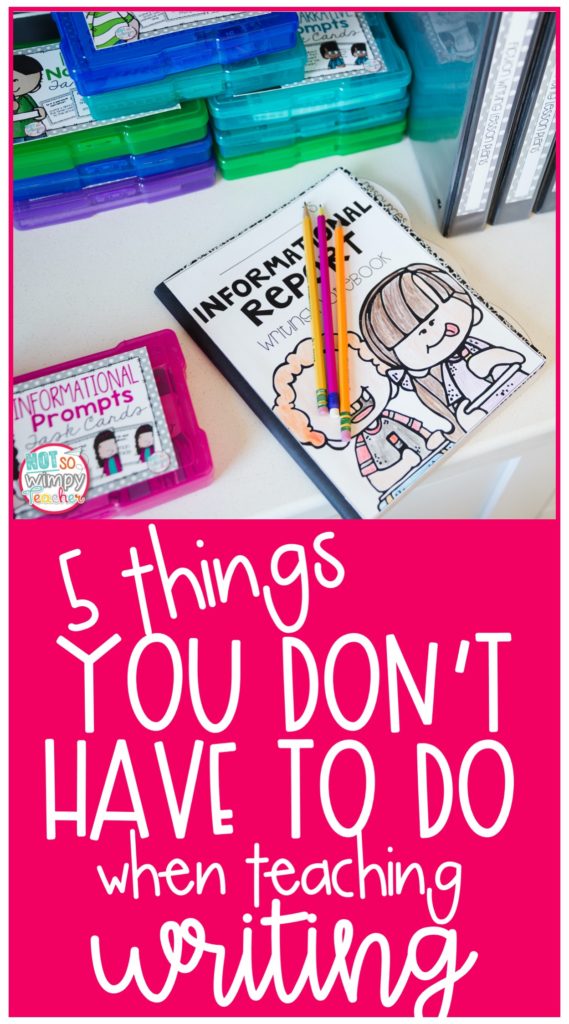
Teachers are almost used to being told that they need to do more – especially in 2020. Learn new technology. Become an effective online teacher. Teach in-person and virtually at the same time. Research new curriculum. The list goes on and on.
I want to switch things up. I want to give you a list of things you DON’T have to do! I have been talking to the teachers in my Not So Wimpy Writing Masterclass. I am finding that teaching writing is difficult for teachers because many are doing more than they have to. Here are five things that you don’t have to do when teaching writing.
1. Assign a New Writing Project Every Week
When I first started teaching writing, I was giving my students a writing project every week. When I was doing my lesson plans on Sunday night, I would search Pinterest and TpT for a simple project that my students could complete within a week.
What’s wrong with weekly projects?
First, it’s a ton more work for you. Every week you will need to come up with a new prompt or purchase a new project. This will increase your prep and planning time.
Secondly, weekly projects are a time waster for your students too. Each project has it’s own unique directions and expectations. Class time will be used every week teaching students how to complete the project. This is class time that is being taken away from the actual act of writing.
Also, moving from one writing assignment to the next so quickly does not give students enough time to learn all of the necessary skills for a writing genre. For example, they cannot learn about strong opinion statements, reasons, examples, hooks, conclusions, transitions, word choice, opposing audience, and editing with a one week project. Writers never have enough time to get confident before you are moving on to the next assignment.
Finally, rushing the lessons teaches students to rush the process. This leads to writers who often skip important steps in the writing process – such as editing.
2. Turn Writing Into a Craftivity or Bulletin Board
I was required to have a large display outside of my classroom with writing and art that had to be changed out every quarter. I understand the pressure to make writing pretty. But, as much as you can, avoid the craftivities in your writing workshop.
Craftivities are generally more about being cute than about writing skill. Students spend more time cutting and gluing than working on word choice and expressing their creativity.
Also, craftivities generally mean that you are telling your students exactly what they must write about. This leads to 25 crafts that are almost identical. That’s not how writing should be! When we allow students to choose a topic that interests them, we get 25 unique and inspired pieces of writing.
A holiday craftivity every now and then is fine! But make sure that the majority of your writing time is filled with more authentic writing. The good news for you? Authentic writing doesn’t require nearly as much prep and almost no supplies. It’s easier for you!
3. Give Students Feedback Every Day
How will I know if they did their writing? How will I know if they understood the lesson? What if they are off track?
I asked myself all of these questions and decided that I absolutely needed to take a look at student writing every day. I was rushing around the room like a chicken with my head cut off trying to give feedback to every student. By the end of writing workshop time, I was exhausted and disappointed. It’s no wonder I stopped protecting our writing time and happily let reading and math run late.
But, here’s the thing. Your students don’t need feedback every day. Even the struggling writers in your classroom don’t need a check-in every day.
When we give feedback and tell students how to improve their writing on a daily basis, we are teaching them to be dependent on us. They don’t learn to be confident and make decisions on their own. They quickly come to the conclusion that they are not good writers and need someone else to make it better. That’s not what we want!
Instead, meet with students once per week. I put all of my writers in groups and met with one group each day while the rest of the class was writing. During this writing conference, I could give feedback and students could ask for support.
The rest of the week, I encouraged them to do their best. It’s ok if they don’t understand every skill or strategy. They can attempt it. Oftentimes, they do better than they gave themselves credit for. Many times I would see them in conferences and find that they hadn’t done as much as I had hoped or they had gotten way off track. But that’s ok. Writing is a journey. The experience helps them to learn.
The crazy thing is that ALL of my writers grew by leaps and bounds. They didn’t write perfectly, but they all wrote significantly better by the end of the year. And more importantly, they were confident and independent writers. That’s reason to celebrate!
4. Correct All Spelling Errors
I am a perfectionist. As a writing teacher I felt that it was my duty to correct every last spelling error in my students’ writing. I would grab a Flair pen and circle every few words in each essay.
Needless to say, I didn’t make my writers too happy.
I took their masterpiece that they had spent weeks “perfecting” and graffitied all over it with pen to let them know how imperfect their writing really was. That’s a punch in the gut for sure.
The reason that I did this was because spelling was the most obvious way that I could improve my students’ writing. It was the low hanging fruit.
When I circled every misspelled word, I wasn’t actually helping my students to become better writers or better spellers. I circled so many words that there was no way they would learn all of the proper spellings. It would just make that one piece of writing better rather than giving the student tools to become a better writer.
When I stopped spending so much time checking spelling, I had more time to teach revising skills. And when I started teaching revising skills, my writers grew in their ability and their confidence. Writing became more fun.
I still taught editing skills and encouraged students to check their spelling using resources. And if I noticed that a student was misspelling the same word over and over, I would help them to learn that particular word.
When my students would publish their final draft, there would be spelling errors. And I learned to be ok with that. They are kids! They should misspell some words. It’s normal.
5. Grade Writing Samples Every Week
Grading writing samples can be very time consuming and joy sucking. But, the good news is that you DON’T need to grade them every week. In fact, I only graded 2-3 samples per quarter.
Remember, doing a new writing sample or project every week doesn’t help our students to get confident with all of the skills required for a genre anyway. (Read more about that in #1 above.)
I know that you need to add grades to the grade book on a regular basis. There are other ways to get writing grades besides a formal writing sample.
- check a small task (such as writing a lead or adding examples)
- completion points
- participation points
- spelling tests
- grammar activities and tests
Just remember that being the teacher who spends every night and every weekend grading does not make you the most effective teacher. Give yourself some grace and look for ways to give feedback without grading nonstop.

Teachers are such hard workers. You always go above and beyond. Know that you are still a super hero when you do less! In fact, when you cut these tasks off of your to-do list, you might just find that you enjoy teaching writing more and your students look forward to writing workshop.
Have a Not So Wimpy day,




















 End of Year Carnival Week for grades 2-5!
End of Year Carnival Week for grades 2-5!
Thank you so much for being a down to earth teacher. I will certainly take your advice. A+ Article
thanks
You are welcome.
Thank you for the wise words and the encouragement.
Very helpful and refreshing tips! How do you modify your writing units for ELL students who are at a kindergarten level or for those students who are below grade level?
Totally agree with this blog! Regarding the spelling, I just have the students underline words they really tried hard to spell but were not sure if they got it right even after using all the strategies taught. This is usually ends up being 2-4 words in their writing piece. I would only look at those words and give a check mark or spell it correctly for them. This makes less marking for me, more accountability for students to try their best, and keeps the confidence level up.
This is a great idea! I definitely will be trying this!
This is why I love your ideas in the Master Class! Time is another which is available if I stop those above suggestions. Thank you for helping me simplify my life. 💗
Is it ok not to publish their writing? We’ve been working on the fictional writing for 9 weeks because we did other writing projects that went with different stories some of the time. I have a few who really want to get their story published and some that are ready to be done.
Publishing students writing is a time for celebration! Students have been working hard on the pieces and should have the opportunity to celebrate their hard work. This blog post have some fun ways to celebrate: https://notsowimpyteacher.com/2018/01/sharing-and-celebrating-student-writing.html